Wednesday, September 4, 2013
Cetina Gorge, Croatia / Mostar, Bosnia i Herzegovina /
Dubrovnik, Croatia
We left Omis at 9:45, through the Cetina Gorge. The scenery
wasn't as dramatic as we'd hoped, but it was very pretty. The best
views were from the top of a series of steep switchbacks at
Zadvarje, where you can see not just the canyon and waterfalls, but
also an abandoned bunker covered with graffiti and a unique-styled
crucifix.
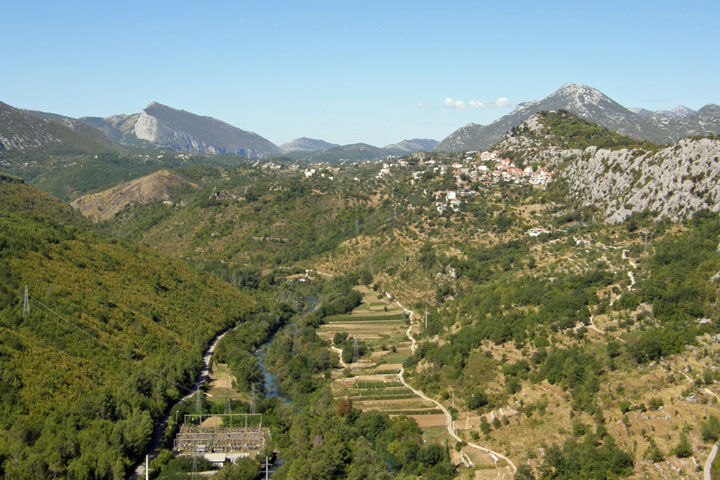
Cetina Gorge from
Zadvarje
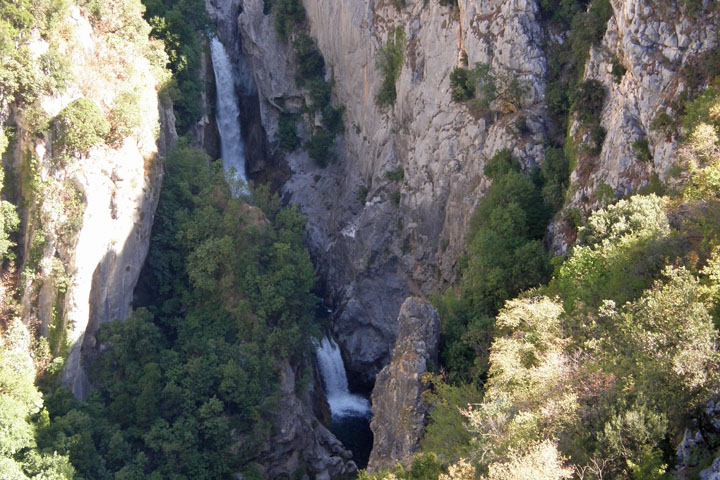
Gubavica vodopad
(waterfall)
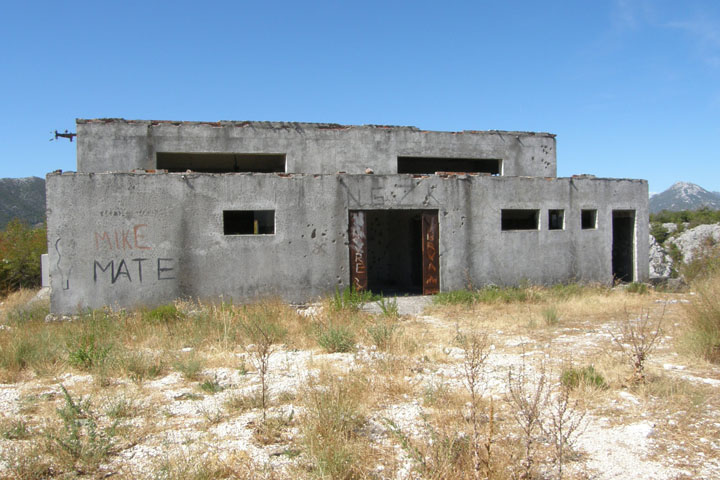
Bunker
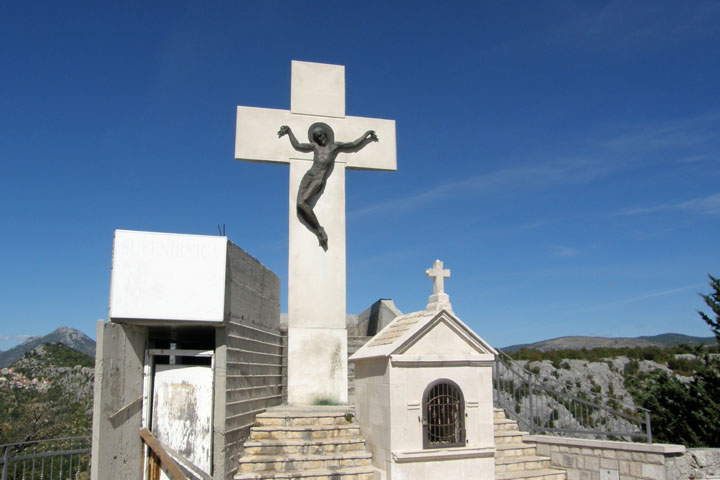
Squiggly
Jesus
Just after noon, we crossed into Bosnia i Herzegovina at Vinjani
Gornji, Croatia / Osoje, Bosnia i Herzegovina and followed the M6-1
to Mostar, arriving around 1:45. Tom pulled over for photos on the
descent to Mostar, and I found a great souvenir by the side of the
road.
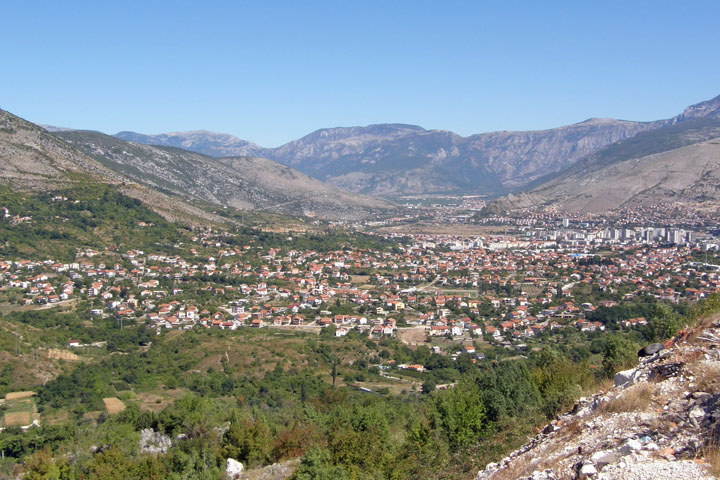
Mostar, Bosnia i
Herzegovina
Mostar, Bosnia i Herzegovina, (population 100,000) is situated on
the Neretva River in a picturesque valley surrounded by mountains.
Muslim Bosniaks live mostly on the east side of the river and
Catholic Croats live mostly on the west side. Before the war in the
'90s when Yugoslavia broke apart, there were also many Orthodox
Serbs living here. There are still a lot of bombed-out buildings
and bullet holes, even though many buildings have been rebuilt.
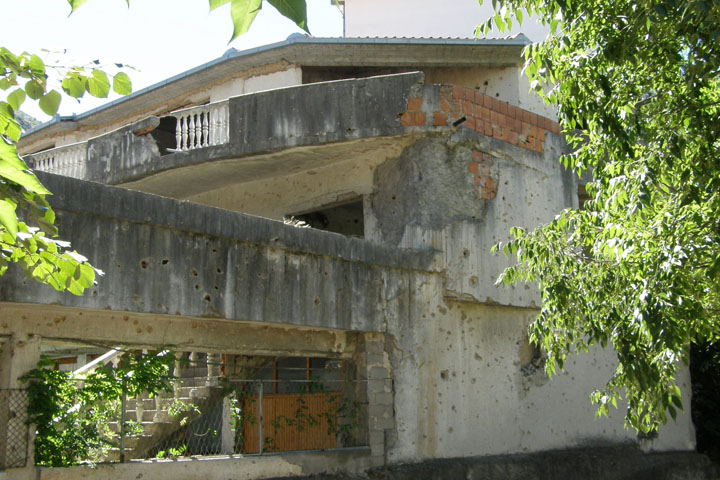
War
damage
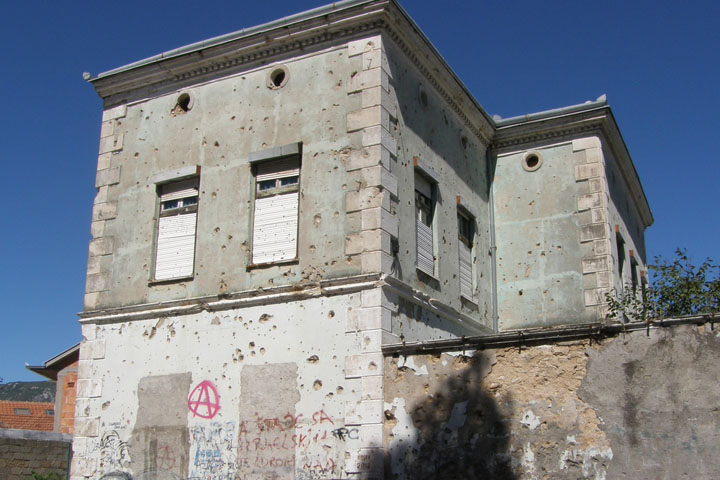
More
damage
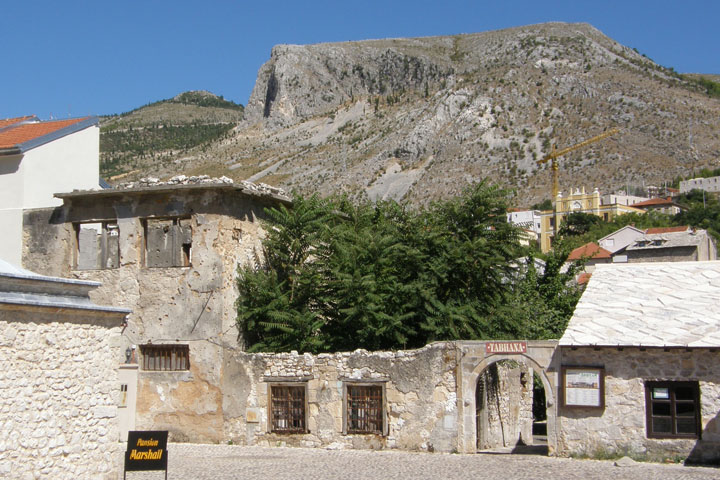
Entering Old Town
Mostar
The Stari Most (Old Bridge) is one of Bosnia i Herzegovina's most
iconic landmarks. It was built in 1566 by the Ottomans and stood
for 427 years, until it was destroyed in the war in 1993. It was
subsequently faithfully reconstructed and reopened in 2004. The
money for the reconstruction was donated by Spain, the United
States, Turkey, Italy, the Netherlands, and Croatia. Mostar is
named after the bridge keepers who guarded the Stari Most in
medieval times. It was probably just called the Most back then.
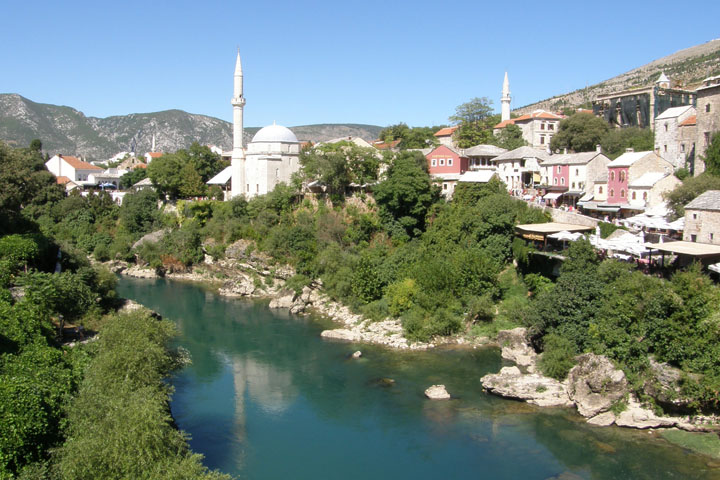
The Muslim side of the
river
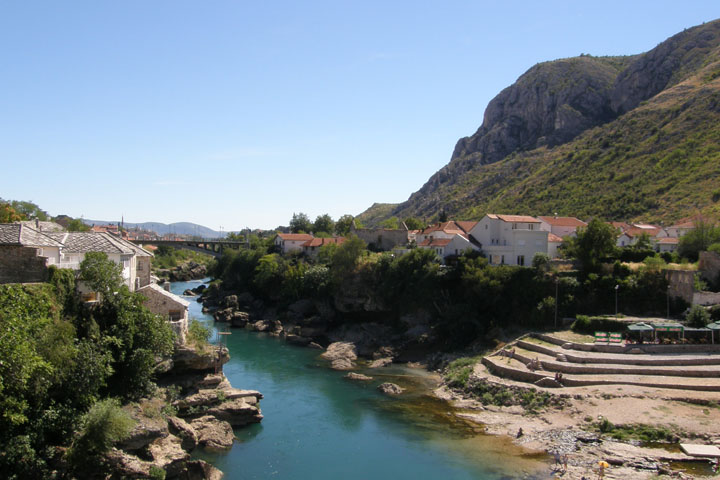
Neretva River from the
Stari Most
It's common for local young men to stand on the bridge and try to
collect money from tourists, with a promise that they'll jump from
the bridge into the river, 75 feet below, when they've collected a
satisfactory sum. When Tom refused to contribute, one of the guys,
apparently guessing correctly that Tom is American, said, “I am
Osama bin Laden; I'm trying to save up for a nuclear bomb.” Nice.
His buddy jumped off the bridge a few minutes later, but I didn't
feel like donating at that point.
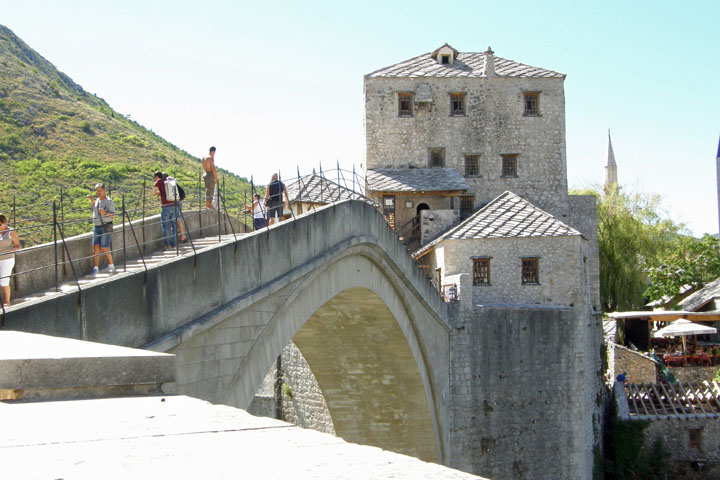
Possible
jumper
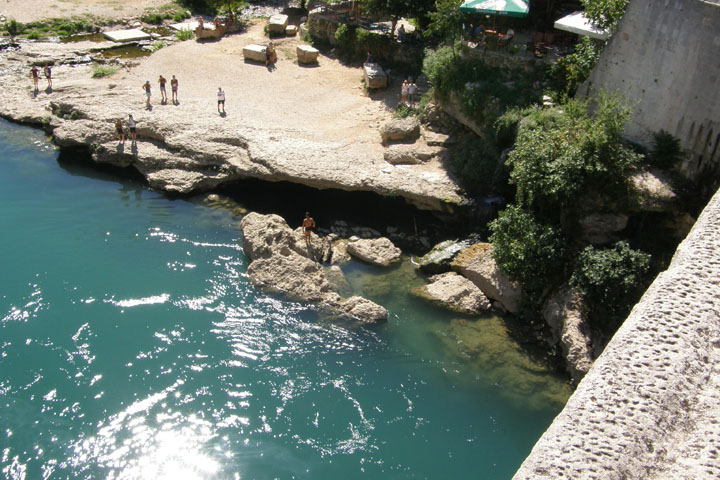
Jumped
On the east side of the river, we toured the Muzej Stari Most (Old
Bridge Museum). There's not much to the museum, but the views are
nice. The windows were grubby, but many of them could be opened. It
was worth the negligible entrance fee (3 convertible marks or 1.5
euro).
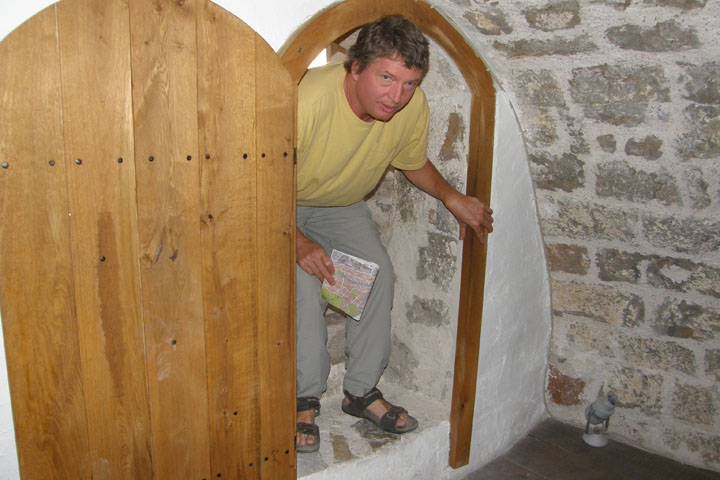
Big Tom, little door,
Muzej Stari Most
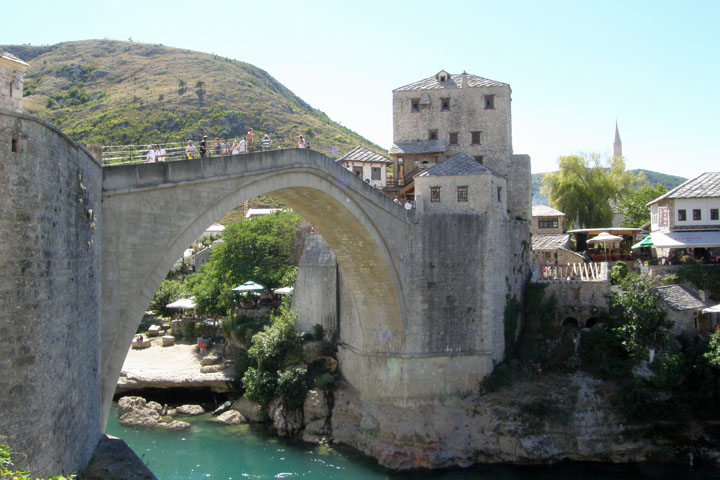
Stari
Most
My favorite place in Mostar was the Koski Mehmed-Pasha Dzamija
mosque. I'd never been in a mosque before. Since they're used to
tourists here, we were allowed to keep our shoes on, and I didn't
have to wear a headscarf. Traditionally, women are segregated to
the balcony, but here they let me roam. The inside of the mosque
was pretty and colorful.
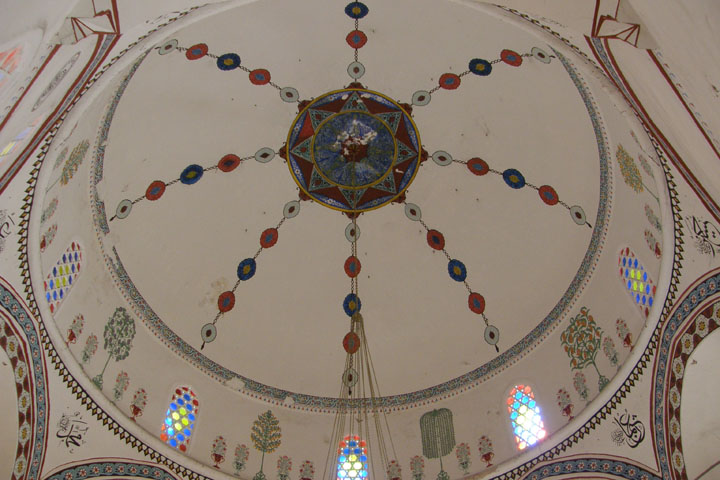
Inside the Koski
Mehmed-Pasha Dzamija
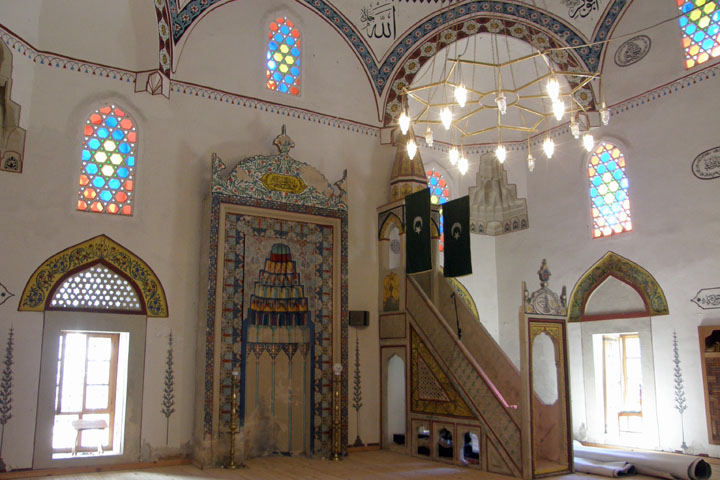
Mosque mihrab and
mimber
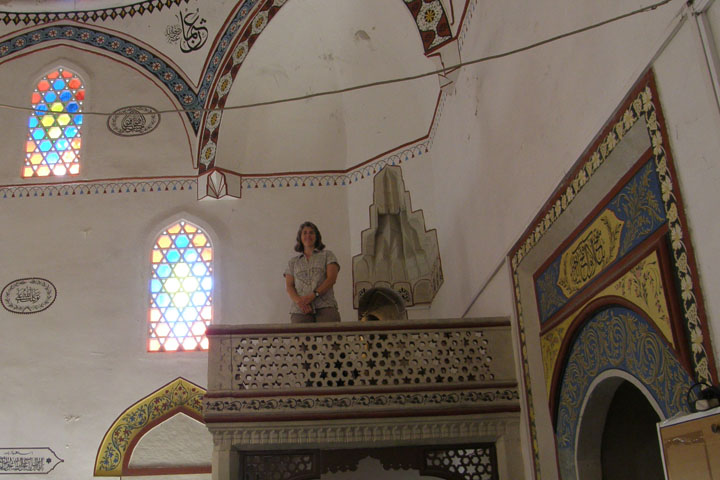
Jana in the
balcony
The climb up the minaret's 89 steps was the most claustrophobic,
winding ascent of our trip, but it was worth it for the stunning
views of the town and river. After a few minutes at the top, we had
it all to ourselves! I'm just glad the call to prayer didn't happen
while we were up there, since the loudspeaker was right by our
heads.
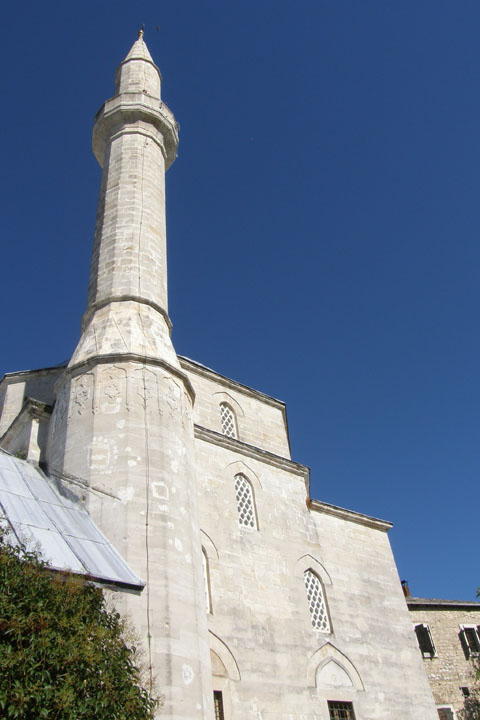
Koski Mehmed-Pasha
Dzamija minaret
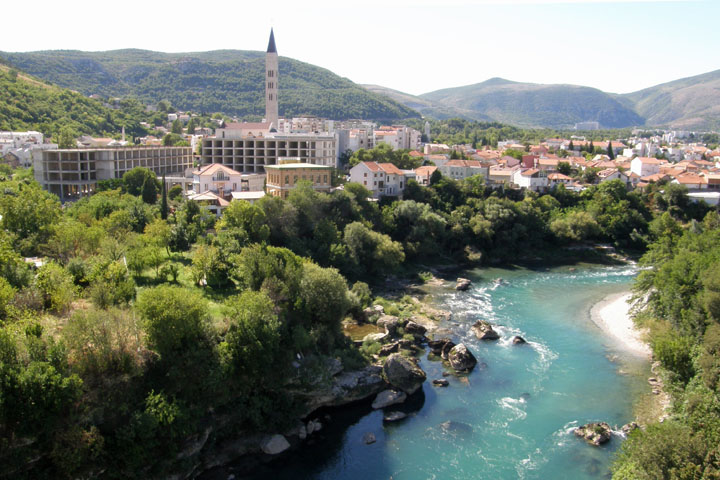
The Catholic side of the
river, from the minaret
After we descended, we went to the back terrace of the mosque, for
the best views of the Stari Most. We also had the terrace to
ourselves, after just a few minutes of sharing it with a Japanese
tourist group. I think we arrived in Mostar just as most of the
day-trippers from Split and Dubrovnik were leaving, so the timing
worked out great!
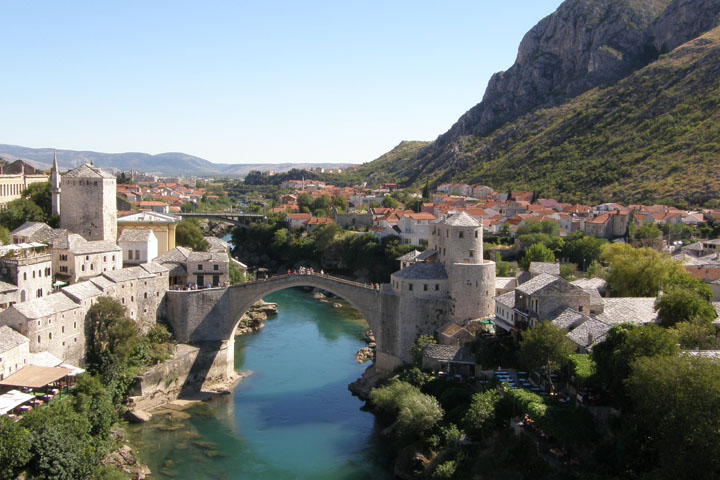
Stari Most from the
mosque back terrace
On our way out of the mosque, I asked the young man at the entrance
how old it was. He said the mosque was built in 1618, but the
minaret was destroyed during the war in the '90s and had to be
rebuilt in 2001. How sad!
We continued up the hill to the New Muslim Cemetery. The cemetery
used to be a park, but during the war, people couldn't reach the
existing cemeteries to bury their loved ones for fear of being shot
by snipers, so they buried them here in the dark of the night.
Every tomb here is dated 1993, 1994, or 1995.
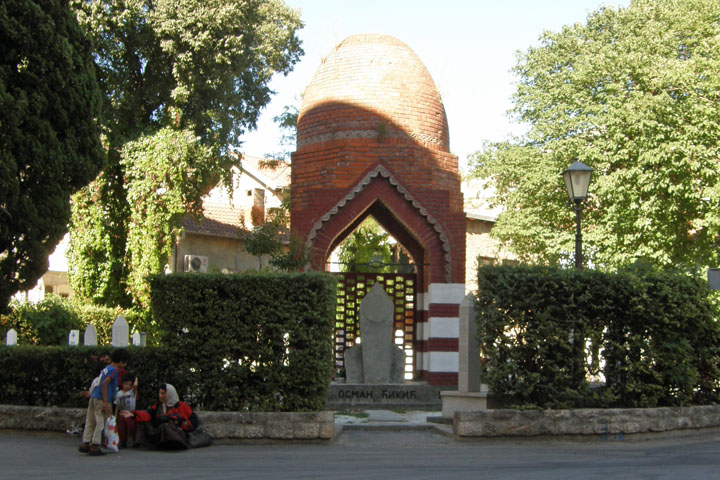
New Muslim
Cemetery
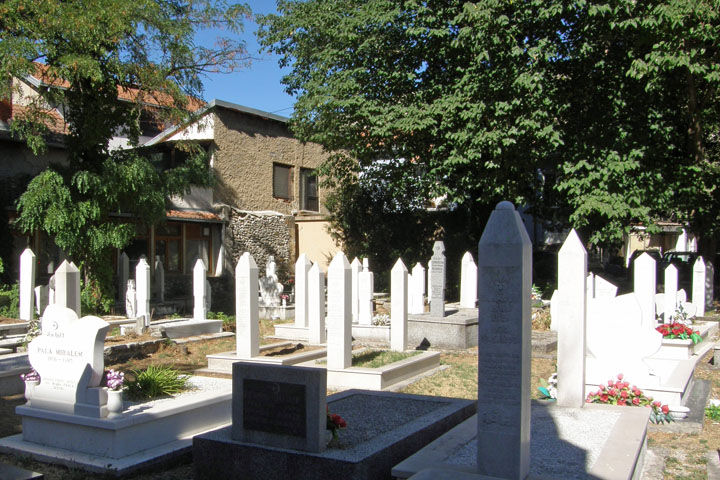
Inside the New Muslim
Cemetery
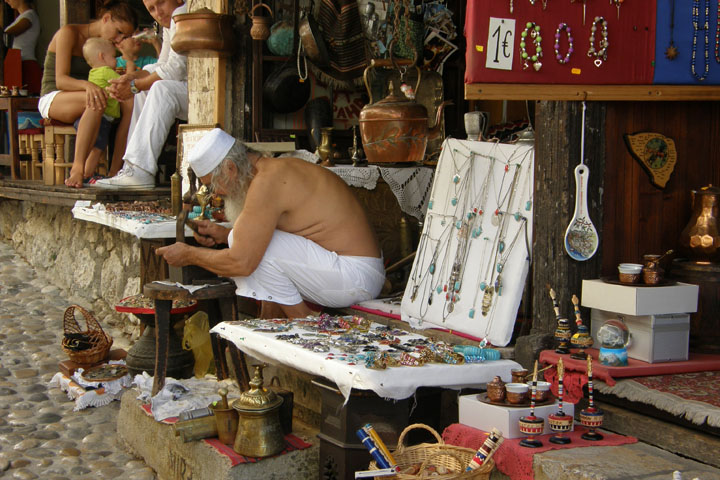
Mostar
Bazaar
Leaving Mostar, we decided to take a less-beaten-track route to
Dubrovnik on Highway 6, via Stolac, Ljubinje, and Trebinje, through
Republika Srpska, the part of Herzegovina controlled by the Serb
minority. We saw tobacco fields, Cyrillic writing, Serbian Orthodox
churches topped with the traditional three crosses, centuries-old,
pre-Ottoman cemeteries, and a man walking his cow down the road on
a leash.
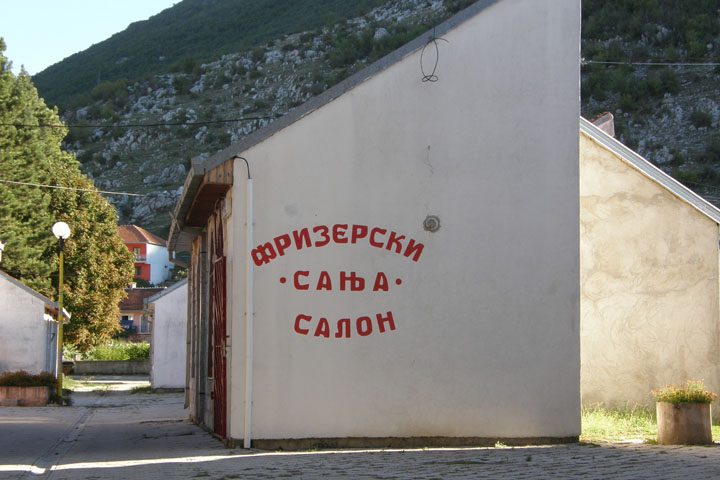
Cyrillic writing,
Ljubinje, Republika Srpska
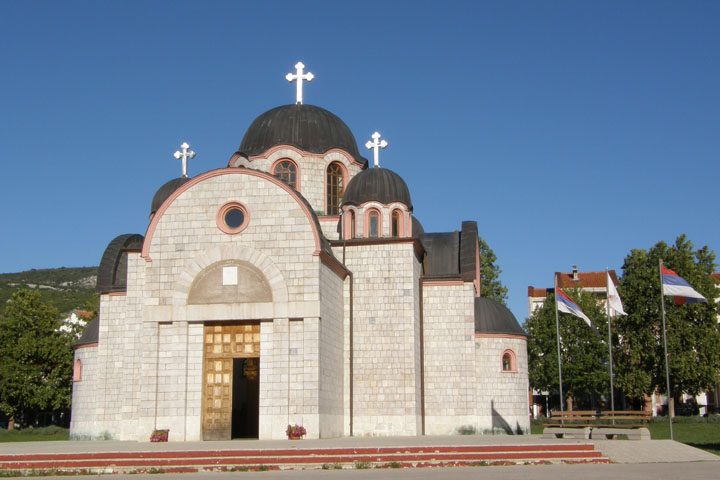
Church of the Nativity
of the Virgin, Ljubinje
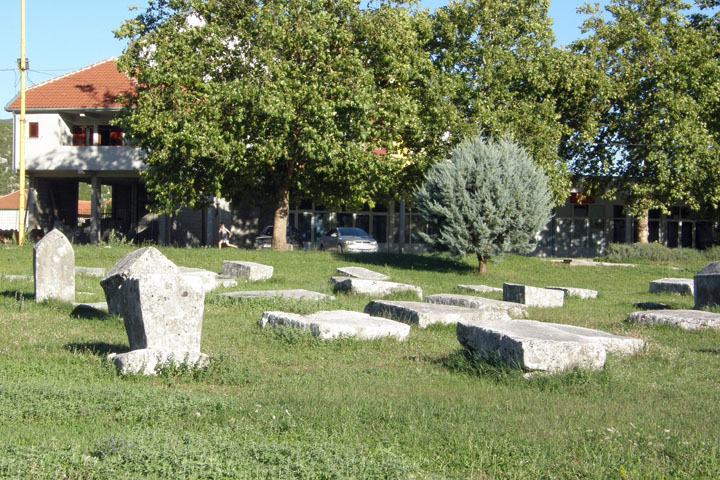
Necropolis with stecak
tombstones
We stopped in Trebinje to look around, and also because Tom wanted
some convertible mark coins for his collection. He tried to get
some in Mostar, but everyone there accepted euros as well as marks,
and since we paid in euros, they gave us euros for change. We gave
a vendor here 2 euros for a bottle of water priced at 1.2
convertible marks and, at Tom's request, received 2.5 marks in
return instead of euro coins. After I paid a mark for parking, that
left him a mark and a half-mark coin as souvenirs. Success!
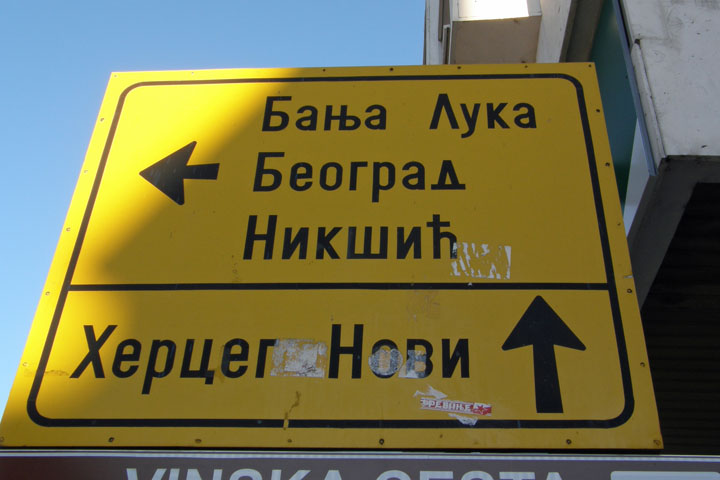
That's easy for you to
say
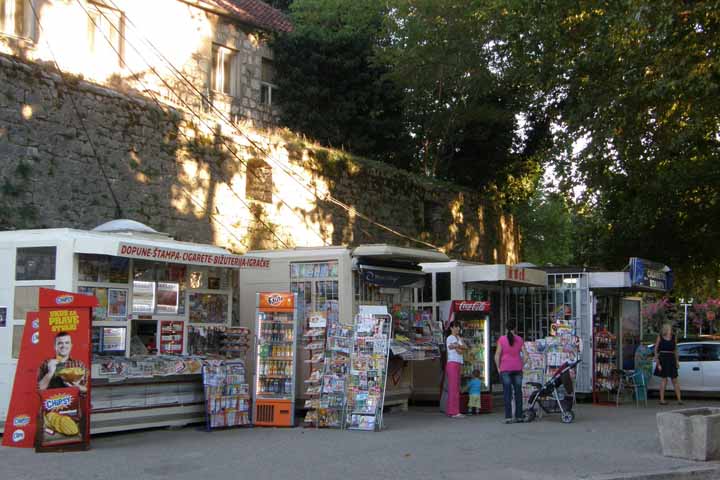
Trebinje street
scene
Trebinje (population 36,000) seemed pleasant and reasonably
prosperous. It's the economic and cultural center of eastern
Herzegovina, at least according to the propaganda I picked up at
the tourist information center. I have no reason to doubt it. Just
because it's propaganda doesn't mean it's not true.
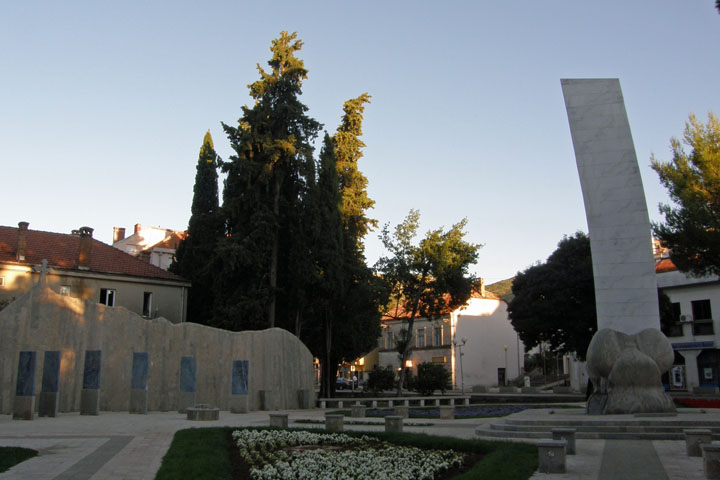
Monument to the
defenders of Trebinje, 1991-1996
Old Town Trebinje is small but cute. We walked the whole thing in
just a few minutes. Tom made friends with a clowder of cats.
Southeastern Europe is overrun by cats. Every city we went to was
crawling with them. I know in Key West they blame the cats on
Hemingway. What's Europe's excuse?
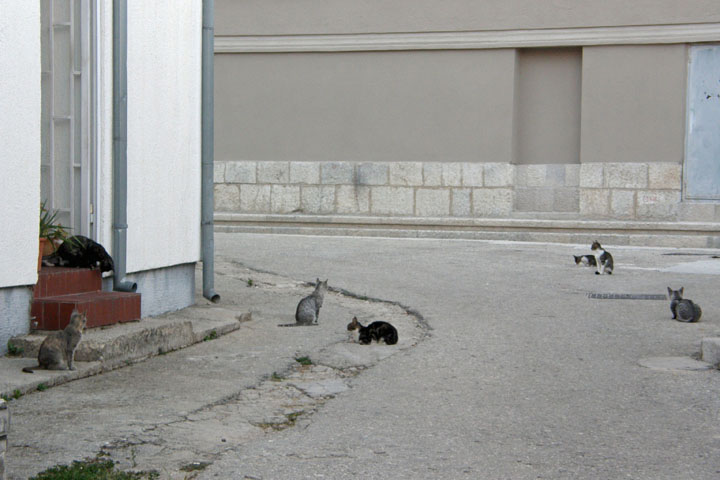
European cat
mob
Gas is cheaper in Bosnia i Herzegovina than in Croatia, so we
filled up the tank before leaving Trebinje. It was 2.41 convertible
marks per liter, so we paid “only” $6.15 a gallon instead of over
$7. An attendant pumped our gas, but we still had to get out of the
car and go in to pay, so I'm not sure how that was helpful. Oh,
well, job creation, I guess.
20 minutes later, we crossed the border at Ivanica, Bosnia i
Herzegovina / Gornji Brgat, Croatia. For the first time, we had to
show our rental car's oh-so-important “green card” (proof of
insurance) to the border agents. I'm glad somebody finally looked
at the darn thing. We watched the sun set as we approached
Dubrovnik on a beautiful descent from the mountains to the
coast.
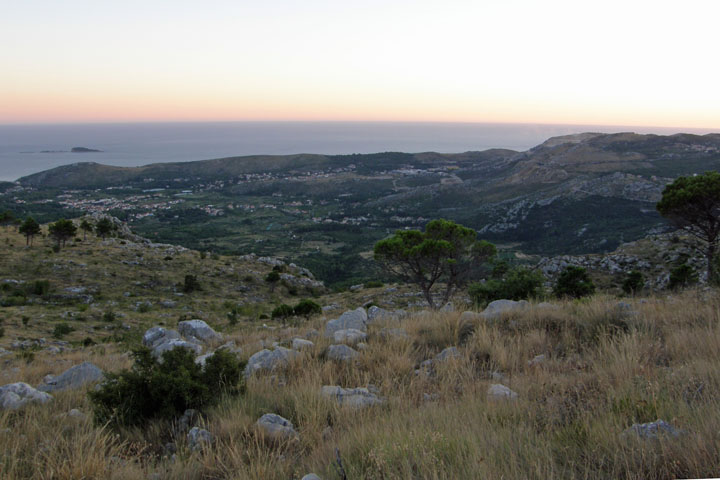
Descending to
Dubrovnik
We arrived at Accommodation Carevic in Dubrovnik, on the Lapad
Peninsula, just before 8:00 p.m. Lapad is 10-15 minutes west of
Dubrovnik's Old Town. Vera, our hostess, spoke almost no English,
but again we managed to check in regardless. All our sobe hosts
have been multilingual, but there's been a lot more German spoken
than English.
This is the only place we'll be staying where we don't have a
bathroom in our room. However, we do have our own private bath;
it's just down the hall. There's only three guestrooms, so we're
not going to run into a lot of people in the hallway. We have our
own balcony, with no view, but there is also a shared balcony with
a view of the mountains. There's also a shared fridge and kettle.
We're a five-minute walk from a grocery store, five minutes from a
bus stop, and 15 minutes from the beach. We're staying in Dubrovnik
four nights.
We had dinner tonight at Konoba Blidinje, on the bay. Tom had
another pizza, while I opted for the seafood risotto. Lovely
seating on the terrace, a nice temperature and a nice sea breeze.
The risotto was good but not outstanding. It was so dark, I had no
clue what I was eating, and I didn't have the language skills to
ask. The beers, as we've come to expect, were boring. When we got
the bill, there was an unexpected 190 kuna “cover charge.” There
wasn't a band, so I have no clue what that was about, but I don't
appreciate it. Tomorrow we will eat elsewhere.
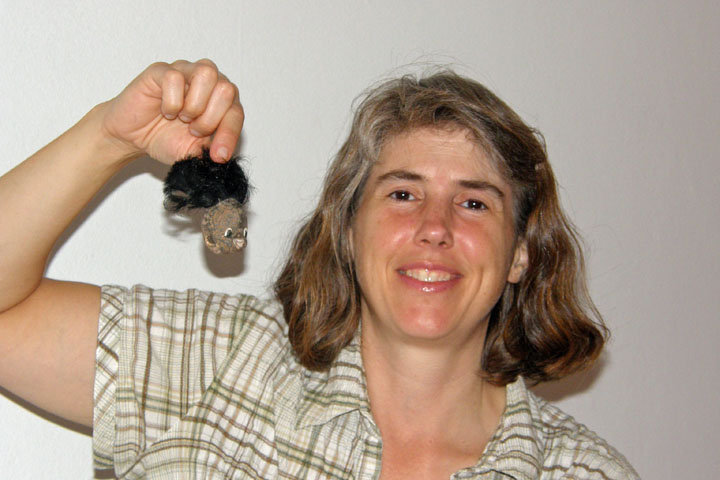
Side-of-the-road
souvenir!
|































